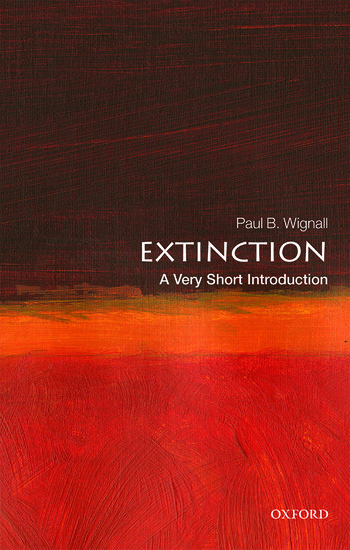Home >
A Very Short Introduction >
Extinction (Science)
A Very Short Introduction | Science
Extinction
ISBN: 9780198807285
Series: A Very Short Introduction
Extinction (Science)
A Very Short Introduction Extinction (Science) Media > Books > Non-Fiction > Education Books Expect Delays of Up to 4 Weeks| Order Below |
ISBN
9780198807285 (10-digit ISBN: 0198807287)
- Description
- Key Features
- Series Description
- Table of Contents
- A single overview of extinction, both past and present, and the individual causes and 'kill mechanisms' which have the potential to cause the destruction of a species
- Offers an up-to-date synthesis of our current understanding of the Earth's 5 big mass extinctions, affecting both land and sea
- Discusses how concerns about extinction sit within current debates surrounding climate change
Most people are familiar with the dodo and the dinosaur, but extinction has occurred throughout the history of life, with the result that nearly all the species that have ever existed are now extinct. Today, species are disappearing at an ever increasing rate, whilst past losses have occurred during several great crises. Issues such as habitat destruction, conservation, climate change, and, during major crises, volacanism and meteorite impact, can all contribute towards the demise of a group.
In this Very Short Introduction, Paul B. Wignall looks at the causes and nature of extinctions, past and present, and the factors that can make a species vulnerable. Summarising what we know about all of the major and minor exctinction events, he examines some of the greatest debates in modern science, such as the relative role of climate and humans in the death of the Pleistocene megafauna, including mammoths and giant ground sloths, and the roles that global warming, ocean acidification, and deforestation are playing in present-day extinctions
Oxford's Very Short Introductions series offers concise and original introductions to a wide range of subjects--from Islam to Sociology, Politics to Classics, Literary Theory to History, and Archaeology to the Bible.
Not simply a textbook of definitions, each volume in this series provides trenchant and provocative--yet always balanced and complete--discussions of the central issues in a given discipline or field. Every Very Short Introduction gives a readable evolution of the subject in question, demonstrating how the subject has developed and how it has influenced society. Eventually, the series will encompass every major academic discipline, offering all students an accessible and abundant reference library.
Whatever the area of study that one deems important or appealing, whatever the topic that fascinates the general reader, the Very Short Introductions series has a handy and affordable guide that will likely prove indispensable.
Please note: As this series is not ELT material, these titles are not subject to discount.
Introduction
1: Causes of extinction
2: Modern extinction and conservation
3: Extinction in the fossil record
4: Mass extinctions
5: Causes of mass extinctions
6: Ice Age extinctions and man
Further reading
Index
Most people are familiar with the dodo and the dinosaur, but extinction has occurred throughout the history of life, with the result that nearly all the species that have ever existed are now extinct. Today, species are disappearing at an ever increasing rate, whilst past losses have occurred during several great crises. Issues such as habitat destruction, conservation, climate change, and, during major crises, volacanism and meteorite impact, can all contribute towards the demise of a group.
In this Very Short Introduction, Paul B. Wignall looks at the causes and nature of extinctions, past and present, and the factors that can make a species vulnerable. Summarising what we know about all of the major and minor exctinction events, he examines some of the greatest debates in modern science, such as the relative role of climate and humans in the death of the Pleistocene megafauna, including mammoths and giant ground sloths, and the roles that global warming, ocean acidification, and deforestation are playing in present-day extinctions
Key Features
- A single overview of extinction, both past and present, and the individual causes and 'kill mechanisms' which have the potential to cause the destruction of a species
- Offers an up-to-date synthesis of our current understanding of the Earth's 5 big mass extinctions, affecting both land and sea
- Discusses how concerns about extinction sit within current debates surrounding climate change
Series Description
Oxford's Very Short Introductions series offers concise and original introductions to a wide range of subjects--from Islam to Sociology, Politics to Classics, Literary Theory to History, and Archaeology to the Bible.
Not simply a textbook of definitions, each volume in this series provides trenchant and provocative--yet always balanced and complete--discussions of the central issues in a given discipline or field. Every Very Short Introduction gives a readable evolution of the subject in question, demonstrating how the subject has developed and how it has influenced society. Eventually, the series will encompass every major academic discipline, offering all students an accessible and abundant reference library.
Whatever the area of study that one deems important or appealing, whatever the topic that fascinates the general reader, the Very Short Introductions series has a handy and affordable guide that will likely prove indispensable.
Please note: As this series is not ELT material, these titles are not subject to discount.
EASY ORDER FORM
PRICES LISTED INCLUDE CONSUMPTION TAX
Price Before Tax:
¥1,790


